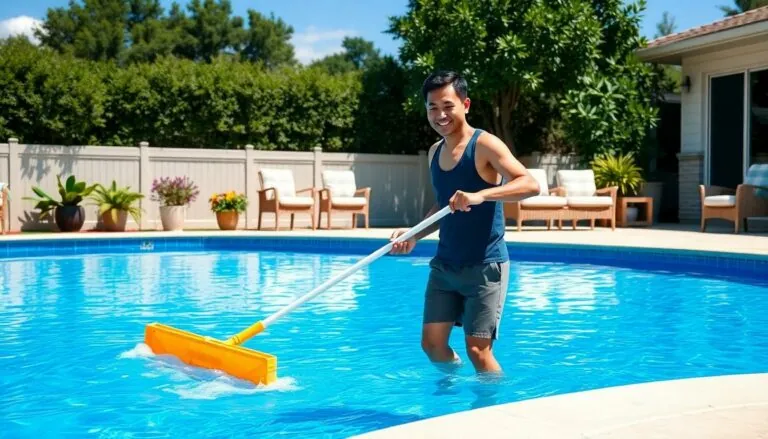Table of Contents
ToggleDiving into pool ownership is like jumping into a refreshing oasis—until the reality of maintenance costs hits. Picture this: you’re lounging by the water, cocktail in hand, when suddenly you remember those pesky upkeep expenses. Don’t worry, you’re not alone in this splashy predicament.
Understanding Average Pool Maintenance Cost
Maintaining a pool incurs varied costs influenced by several factors. Understanding these aspects helps pool owners better manage their budgets.
Factors Influencing Cost
Frequency of maintenance impacts total expenses. Routine servicing, including cleaning and chemical balancing, averages $100 to $150 per visit. Type of pool also plays a role; in-ground pools often require more care than above-ground ones. Equipment condition further influences costs. If filters and pumps work inefficiently, they demand additional upkeep. Seasonal changes affect pool maintenance as well. For instance, spring and summer require more attention, leading to increased costs during those months.
Regional Differences in Pricing
Pricing varies significantly across different regions. Owners in suburban areas might face $70 to $120 per service, while urban locations often see costs rise to $150 or more. Local labor rates contribute to these differences, with higher wages reflecting in service prices. Additionally, climate impacts maintenance frequency; warmer regions require regular upkeep throughout the year. States with low temperatures typically see reduced services in winter months, potentially lowering overall yearly expenses.
Breakdown of Maintenance Services
Pool maintenance includes various services essential for keeping the water clean and ensuring safe swimming conditions. Each service contributes to the overall health of the pool.
Cleaning and Chemical Balance
Cleaning involves vacuuming debris, skimming leaves, and brushing walls. A basic cleaning service typically costs between $70 to $120 per visit, depending on the pool type and its condition. Chemical balance requires testing pH levels, alkalinity, and chlorine content. Regular testing and adjustments are crucial. Homeowners spend an average of $25 to $50 monthly on chemicals. Seasonal needs increase, especially during peak summer months, as higher temperatures can elevate chemical demand.
Equipment Repairs and Replacements
Pool equipment maintenance focuses on filters, pumps, and heaters. Regular inspections help identify issues before they escalate, preventing costly emergency repairs. Repair costs vary, with minor fixes ranging from $50 to $150. Major replacements, such as a pump or heater, can total $500 to $2,000. Budgeting for unexpected equipment failures is important for pool owners. Investing in routine maintenance significantly extends the lifespan of pool equipment, ultimately saving money.
Cost-Saving Tips for Pool Owners
Pool ownership comes with the responsibility of managing costs. Implementing smart strategies can significantly reduce expenses.
DIY Maintenance vs. Professional Services
DIY maintenance offers an effective way to save on costs. Pool owners can handle several tasks like skimming debris and checking chemical levels. Familiarity with equipment can minimize labor expenses. However, some maintenance aspects require expertise. Complex repairs or equipment installations may be best left to professionals. Hiring a service ensures the job is done correctly, preventing costly mistakes. Balancing do-it-yourself efforts with professional help optimizes savings without compromising the pool’s condition.
Seasonal Maintenance Adjustments
Adjusting maintenance routines seasonally proves cost-effective. Spring and summer necessitate more frequent cleaning due to increased debris and usage. Owners can cut costs by increasing DIY activities during warmer months. Fall and winter maintenance should focus on closing procedures and winterizing systems. Lowering operational demands in colder months requires fewer professional visits. Taking seasonal factors into account helps pool owners maintain budget control while ensuring a clean and safe swimming environment throughout the year.
Budgeting for Pool Maintenance
Budgeting for pool maintenance involves understanding ongoing expenses associated with ownership. Predictable costs arise from regular maintenance, ensuring that the pool remains clean and safe.
Creating a Maintenance Schedule
Creating a maintenance schedule helps manage pool upkeep effectively. Establishing a weekly or bi-weekly routine works well for many owners, as frequent visits prevent larger issues. Scheduling tasks like vacuuming and chemical balancing ensures consistency. During peak seasons, increasing the frequency of cleaning sessions often proves beneficial. Owners should also note seasonal demands, such as winterization, for proper planning. Matching the schedule with local weather patterns facilitates maintenance alignment with natural circumstances. Ultimately, adherence to a structured timetable lowers unexpected costs.
Long-Term Financial Considerations
Long-term financial considerations significantly impact pool ownership finances. Considering the lifespan of equipment is crucial for budgeting; regular inspections help identify potential issues early. Accumulating minor repair costs of $50 to $150 can add up over time, leading to more substantial expenses. Understanding when to invest in replacing items like filters or pumps, which range from $500 to $2,000, is necessary for effective financial planning. Prioritizing maintenance extends equipment longevity and prevents unforeseen expenses. By building a reserve for unexpected costs, owners can ensure smooth financial management and peace of mind.
Owning a pool offers a refreshing escape but comes with its share of financial responsibilities. Understanding the average maintenance costs is crucial for effective budgeting. By being proactive and implementing cost-saving strategies, pool owners can enjoy their oasis without breaking the bank. Regular maintenance not only extends the life of the pool but also prevents unexpected expenses down the line. With careful planning and a focus on seasonal needs, managing maintenance costs becomes a more straightforward task. Ultimately, a well-maintained pool is not just an investment in property but also in enjoyment and relaxation.



